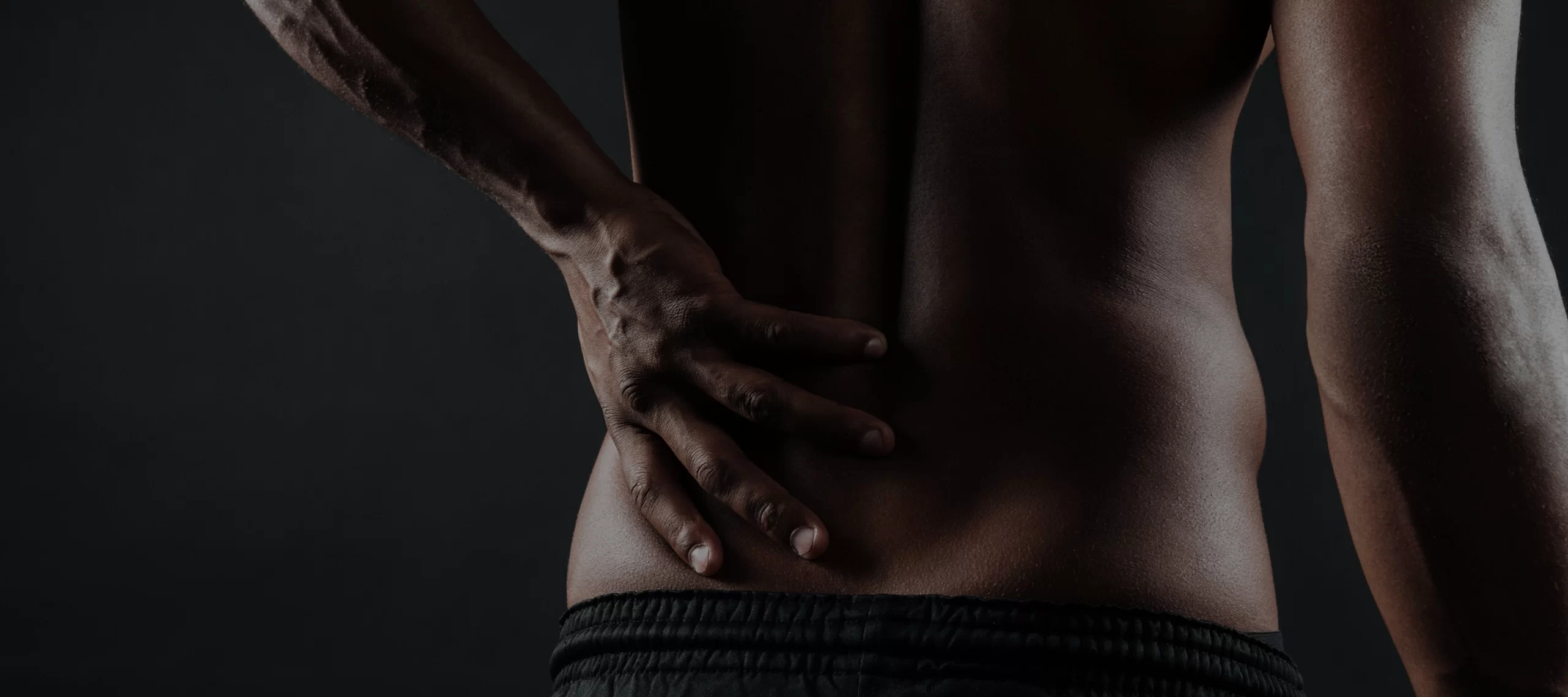
Back Pain Management in Kentucky
Bux Pain Management offers comprehensive back pain relief for people experiencing chronic or acute back pain. We provide personalized, minimally invasive treatments such as anesthetic injections, spinal decompression, and spinal cord stimulation to help reduce pain and restore mobility.
Led by board-certified anesthesiologist Dr. Anjum Bux, our team specializes in evidence-based procedures such as epidural injections, neurostimulation therapy, joint injections, and intrathecal therapy. Whether your back pain stems from injury, arthritis, or long-term spinal conditions, we create personalized treatment plans that focus on lasting relief, improved mobility, and better quality of life.
Contact Bux Pain Management or book online to start your path toward effective back pain relief today. Our goal is not only to ease pain but also to help patients stay active, return to daily routines, and enjoy greater independence.
What Is Back Pain Management?
Back pain management is the medical evaluation and treatment of pain that originates in the spine, muscles, or nerves of the back. Pain may develop in the cervical (neck), thoracic (mid-back), lumbar (lower back), or sacral region at the base of the spine near the pelvis. Back pain is commonly classified as mechanical, caused by issues with muscles, joints, discs, or ligaments, or neuropathic, caused by irritation or compression of spinal nerves.

Some of the clinical terms you may hear include:
- Dorsalgia – general medical term for back pain
- Lumbago – pain in the lower back
- Sciatica – radiating pain along the sciatic nerve, often down the leg
- Radiculopathy – nerve pain, numbness, or weakness from spinal nerve compression
- Spondylosis – degeneration of the spine, often related to aging
- Herniated disc – disc material that presses on nearby nerves
- Spinal stenosis – narrowing of the spinal canal that compresses nerves
Importance of Back Pain Management
Back pain management matters because untreated pain can interfere with nearly every part of daily life. Beyond the discomfort itself, back pain can limit mobility, interrupt sleep, and make it difficult to participate in routine activities.
Effective management provides:
- Pain relief that reduces discomfort and restores comfort
- Improved mobility, helping you move more freely and confidently
- Emotional relief, as managing pain often lessens stress, frustration, and fatigue
- Work productivity, since addressing pain supports focus and reduces missed days
With the right treatment plan, many patients can resume activities they enjoy and regain confidence in their physical abilities. Seeking professional care is the first step toward achieving long-term relief and an improved quality of life.
Chronic vs. Acute Back Pain
Back pain is often categorized as acute or chronic, depending on how long symptoms last and how they respond to treatment. Acute back pain typically comes on suddenly, often after an injury or strain, and may resolve within a few weeks. Chronic back pain, by contrast, persists for 12 weeks or longer, even after the initial cause has been treated, and often requires more comprehensive management strategies.
| Acute Back Pain | Chronic Back Pain | |
|---|---|---|
| Duration | Typically lasts a few days to several weeks | Persists for 12 weeks or longer |
| Causes | Often linked to injury, strain, or sudden movement | May result from structural changes, degenerative conditions, or nerve involvement |
| Recurrence | May resolve completely, but can recur | Frequently recurs or persists without full resolution |
| Treatment Variation | Short-term therapies such as rest, heat, or injections | Multimodal approach including interventional therapies, physical therapy, and lifestyle changes |
Recognizing the difference between acute and chronic back pain is clinically important. Early diagnosis and tailored treatment can prevent temporary pain from developing into a long-term condition that affects mobility, work, and overall well-being.

Causes of Back Pain
Back pain can arise from a wide range of conditions. Broadly, the causes can be categorized into structural conditions, inflammation, mechanical stress, neurological involvement, and direct trauma. Identifying the right category is the first step in understanding why pain develops and how to treat it effectively.
- Structural causes – herniated discs, arthritis, spinal stenosis, or other degenerative changes in the spine
- Inflammatory causes – swelling or irritation in the joints and soft tissues of the back
- Mechanical causes – poor posture, repetitive strain, or weak supporting muscles
- Neurological causes – nerve compression leading to sciatica, radiculopathy, or neuropathic pain
- Traumatic causes – direct trauma caused by injury, accidents, or sports impact
Structural Causes
Structural causes of back pain occur as the spine naturally changes with age. Discs lose hydration and flexibility, while vertebrae may develop arthritis or bone spurs. These degenerative changes reduce stability and increase the risk of nerve compression.
When nerves are pressed, patients often experience numbness, tingling, weakness, or reduced range of motion. Everyday movements may become painful, and mobility can steadily decline.
Common structural conditions include:
- Herniated disc – bulging disc material pressing on nearby nerves
- Spinal stenosis – narrowing of the spinal canal that compresses nerves
- Degenerative disc disease – gradual breakdown of discs leading to stiffness and pain
- Spondylosis – age-related arthritis of the spine that reduces mobility
Inflammatory Causes
Inflammation in the spine and surrounding joints is a common source of back pain. Arthritis, in particular, can inflame the joints that connect the vertebrae, leading to joint pain, stiffness, and swelling that often worsens after periods of rest. These symptoms may limit movement and make everyday activities more difficult.
Unlike sudden injuries, inflammation tends to be chronic. Many patients experience cycles where symptoms flare up and then ease, only to return again. This recurring pattern can gradually reduce flexibility and mobility if left untreated.
Mechanical Causes
Mechanical causes of back pain develop from the way the body is used day to day. Poor posture, repetitive lifting, or long hours sitting can overload the muscles and ligaments that support the spine, leading to strain and recurring pain.
Common contributing factors include:
- Poor posture – slouching or sitting improperly for extended periods
- Repetitive strain – frequent lifting, bending, or twisting
- Sedentary habits – lack of regular movement that weakens muscles
- Poor ergonomics – workstations or seating that fail to support the spine
These habits gradually weaken core and back muscles, reducing stability and flexibility. Over time, the spine becomes more prone to discomfort, even during simple movements.
The good news is that mechanical back pain is often preventable. Paying early attention to posture, using ergonomic setups, and practicing safe lifting techniques can protect spinal health. With small, consistent changes, patients can meet daily demands while lowering the risk of long-term pain.
Neurological Causes
Neurological causes of back pain occur when spinal nerves are compressed or irritated. This pressure disrupts nerve signaling and can create sharp, shooting pain that radiates into the arms or legs. Patients may also experience numbness, tingling, or weakness that affects balance and mobility.
One of the most common examples is sciatica, which develops when the sciatic nerve in the lower back is pinched or inflamed. The result is radiating pain that often extends down one leg and can interfere with walking or standing.
Because nerve-related pain shares symptoms with other spinal conditions, accurate diagnosis is essential. Imaging tests such as MRI or CT scans are often used to confirm the source of compression and guide the most effective treatment plan.
Traumatic Causes
Trauma-related back pain develops from sudden injury to the spine or supporting tissues. Accidents, falls, or sports collisions can damage muscles, ligaments, or vertebrae, while even one episode of heavy or improper lifting may strain discs or joints.
These injuries range from soft tissue damage, such as sprains and muscle tears, to more serious fractures of the vertebrae. Symptoms may appear immediately or gradually, often including sharp pain, swelling, or limited movement.
Any severe or sudden-onset back pain after trauma should be evaluated promptly. Early diagnosis helps prevent complications, supports proper healing, and reduces the risk of long-term damage.

What Are the Symptoms of Back Pain?
Back pain can show up in different ways depending on which part of the spine is affected. These are some of the most common signs patients notice:
- Localized pain: Aching or soreness in a specific part of the back. Lower back pain is the most common and may be related to discs or muscles. Mid-back pain can develop from posture or joint strain, while upper back discomfort is often tied to tension or arthritis. Muscle spasms may also occur, creating brief episodes of tightness.
- Stiffness: A feeling of reduced flexibility, often most noticeable in the morning or after sitting still. Stiffness is usually related to inflammation or joint changes and can ease as you begin moving around.
- Radiating sensations: Pain that travels beyond the back into the legs or arms. Sciatica is a common example, where the sciatic nerve is irritated and pain extends down one leg. Some people may also feel tingling, pins-and-needles, or mild weakness in the limbs.
- Limited mobility: Difficulty with everyday movements such as bending, walking, or turning comfortably. When mobility is reduced, routine tasks can feel more challenging, but treatment often helps restore function.
Effective Back Pain Diagnosis by Bux Pain Management Specialists
Accurate diagnosis is the foundation of successful back pain treatment. At Bux Pain Management, the process begins with a detailed physical exam to evaluate pain location, range of motion, and overall function. This hands-on assessment helps identify possible causes and guides which diagnostic tests may be needed.
Imaging tools, such as X-rays, provide a deeper look at the spine’s structure to confirm conditions like fractures, arthritis, or scoliosis. Patient-reported pain scales are also used to measure severity and track progress over time.
Together, these diagnostic steps give our specialists a clear understanding of each patient’s condition and allow for the creation of a personalized treatment plan tailored to long-term relief.
- Physical exam: A thorough physical exam is an essential first step in diagnosing back pain. It may involve palpation to detect tenderness, range of motion testing, neurological checks, and posture assessments. These observations provide immediate insight into the severity and nature of the pain. When combined with imaging, the exam creates a complete picture of the condition and guides the development of a personalized treatment plan.
- X-ray: X-rays are a valuable first-line imaging tool for identifying spinal conditions. They can detect fractures, arthritis, scoliosis, and other structural changes in the bones and joints of the back. By providing clear images of alignment and degeneration, X-rays help confirm or rule out causes of pain and guide the next steps in care.
- Pain scale: The Numeric Pain Rating Scale (NPRS) asks patients to rate their pain on a scale from 0 (no pain) to 10 (worst imaginable pain). This simple tool helps providers assess severity, monitor changes over time, and adjust treatment plans accordingly. At Bux Pain Management, the NPRS is used alongside imaging and physical exams to ensure pain is managed effectively and outcomes steadily improve.

Treatment Options for Back Pain Management
There are many approaches to managing back pain, and the best option depends on each person’s condition, symptoms, and overall health. At Bux Pain Management, the focus is on minimally invasive treatments designed to relieve pain and restore mobility while helping patients return to daily activities. Every plan is personalized, meaning care is tailored to the specific cause of pain and the individual’s goals.
Here’s a closer look at different treatment options:
- Medications for Back Pain: Medications are sometimes used to relieve symptoms and reduce inflammation. Options may include over-the-counter medicines or, in some cases, stronger prescriptions for short-term relief of severe pain. These are used carefully and as part of a broader treatment strategy.
- SynchroMed™ III Pain Pump: An advanced implantable device that delivers pain medication directly to the spinal fluid, targeting pain at its source while reducing side effects. MRI-compatible and designed for long-term management, it offers a safe, effective option for patients with chronic back pain who haven’t found relief through other treatments.
- SI Joint Fusion: For patients with sacroiliac joint dysfunction, this procedure stabilizes the sacroiliac joint to reduce abnormal motion and associated pain. It is typically considered when other, less invasive options have not provided relief.
- Joint Injections: Injections deliver medication directly into affected joints to reduce pain and inflammation. These may be used for arthritis or injury-related pain, and can also target the sacroiliac joint for lower back or pelvic pain.
- Neurostimulation Therapy: Neurostimulation therapy uses a small device to send electrical impulses that modify pain signals traveling to the brain. It can be helpful for certain chronic back conditions and is designed to provide long-term relief and improve quality of life.
- Epidural Injections: A minimally invasive procedure delivers medication to the area around the spinal cord to reduce inflammation and nerve irritation. It may be used for back pain linked to conditions like disc problems or spinal stenosis.
- Lumbar Spinal Stenosis Therapy (Vertiflex): A minimally invasive spinal decompression option where a small implant relieves pressure on spinal nerves in the lower back. It can improve mobility and reduce pain with shorter recovery times than traditional surgery.
- Intrathecal Therapy: Intrathecal therapy delivers pain-relieving medication directly around the spinal cord through an implanted device. It is sometimes recommended for chronic conditions when other treatments haven’t been effective.
- Radiofrequency Ablation (RFA): A procedure that uses heat to disrupt pain signals from targeted nerves, providing lasting relief for certain types of chronic spinal pain.
Preventive Measures for Back Pain
While treatment can relieve back pain, prevention plays an equally important role in long-term comfort and mobility. Developing healthy habits for movement, posture, and daily routines helps protect the spine from unnecessary strain.
Stretching and Strengthening Exercises
Stretching and strengthening are key to keeping the back flexible, supported, and balanced. Gentle stretching improves mobility in the muscles surrounding the spine, while strengthening the core and back muscles helps stabilize and protect the body during movement. Together, they promote better posture and reduce the likelihood of strain.
Examples of supportive exercises include:
- Light stretching for the hamstrings, hips, and lower back
- Core-strengthening moves like planks or bridges
- Balance-focused routines such as yoga or Pilates
- Mobility exercises designed to keep joints flexible
Consistency is more important than intensity. Regular practice can help build lasting strength and flexibility to support spinal health.
Posture and Ergonomics
Posture has a direct impact on spinal health. Sitting or standing with the spine aligned reduces stress on muscles, discs, and ligaments, while poor posture over time can lead to discomfort and chronic strain.
Practical ergonomic tips include:
- Supportive seating – choose chairs with proper lumbar support
- Screen position – keep monitors at eye level to avoid slouching
- Workstation tools – use adjustable desks, cushions, or footrests when possible
- Movement breaks – stand and stretch regularly during long periods of sitting
These small adjustments in daily routines create healthier alignment and reduce the risk of posture-related back pain.
Lifestyle Changes for Long-Term Relief
Lifestyle choices influence not just overall health but also the way the body manages and recovers from back pain. Sustainable changes can reduce risk factors and support long-term relief.
Helpful adjustments include:
- Weight management – maintaining a healthy weight lessens pressure on the spine
- Smoking cessation – avoiding smoking improves circulation and spinal healing
- Regular fitness – staying active strengthens muscles and promotes flexibility
- Stress management – relaxation techniques like meditation can ease muscle tension
By making gradual, supportive changes and staying consistent, individuals can build a foundation for better spinal health and reduced back pain over time.
Recovery and Prognosis
Recovery from back pain varies depending on the cause, severity, and whether symptoms are acute or chronic. While some people improve within weeks, others may need ongoing strategies to manage long-term conditions.
With appropriate care, most patients regain mobility, resume normal activities, and experience a better quality of life. At Bux Pain Management, we support patients in setting realistic expectations and creating plans that encourage steady progress.
Recovery Time Expectations
Acute back pain, such as a strain or minor injury, often improves within a few days to a few weeks. Chronic back pain, on the other hand, may last three months or longer and usually requires a more structured management plan. Recovery timelines are influenced by factors like overall health, activity levels, the specific cause of pain, and adherence to treatment or preventive measures.
Long-Term Outcomes
Long-term outcomes for back pain vary, but most patients can expect to resume daily activities with reduced discomfort when appropriate strategies are in place. Some conditions carry a risk of recurrence, which makes ongoing self-care, posture awareness, and regular activity important.
Monitoring Progress
Tracking recovery helps ensure that treatment remains effective and adjustments are made as needed. Progress monitoring also provides reassurance, as small improvements can build up over time.
Tools for tracking include:
- Pain scales – rating pain levels regularly to measure changes
- Activity logs – noting improvements in daily movement or endurance
- Reassessment intervals – periodic check-ins with a provider to update the care plan
At Bux Pain Management, we work with patients to track progress and make changes when necessary, ensuring recovery stays on course and long-term outcomes continue to improve.
Frequently Asked Questions
What does pain management do for back pain?
Pain management helps identify the source of back pain and offers treatments designed to reduce discomfort, improve mobility, and support daily function. This may include medications, minimally invasive procedures, and lifestyle strategies tailored to each patient.
How to get rid of back pain instantly?
There is no guaranteed way to eliminate back pain instantly. Some people find temporary relief with rest, gentle stretching, ice or heat, or over-the-counter medications. For lasting results, professional evaluation and a tailored treatment plan are usually needed.
What causes lower back pain in females?
Lower back pain in women can be related to muscle strain, arthritis, spinal conditions, or reproductive health factors such as endometriosis or menstrual cycles. Each case is unique, so a full evaluation is important to determine the exact cause.
When does back pain start in pregnancy?
Back pain can begin at any stage of pregnancy, though it is most common in the second and third trimesters. Hormonal changes, weight gain, and shifts in posture often contribute to discomfort during this time.
Can constipation cause back pain?
Yes. Constipation can place pressure on the lower back and cause discomfort or achiness. If constipation is frequent or severe, addressing it can help reduce associated back pain.
